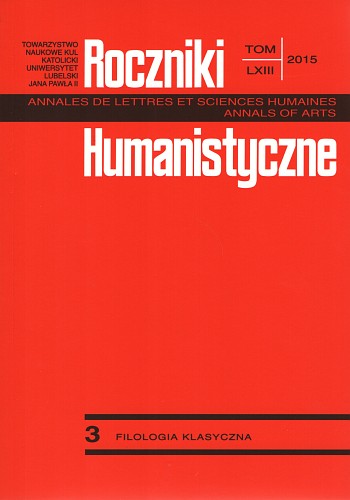Tesalska i kreteńska nazwa tykwy pospolitej
The Thessalian and Cretan name for ‘bottle gourd’
Author(s): Elwira Kaczyńska, Krzysztof Tomasz WitczakSubject(s): Philology
Published by: Towarzystwo Naukowe KUL & Katolicki Uniwersytet Lubelski Jana Pawła II
Keywords: botanical names;Cretan dialect;Greek dialectology;Greek vocabulary
Summary/Abstract: In his work Deipnosophistae (IX 369b) Athenaeus discusses four Greek names for ‘turnip, Brassica campestris L., syn. Brassica rapa L.’, namely βουνιάς, γογγυλίς, Laconian γάστρα and Boeotian ζεκελτίς. Three first appellatives are clearly motivated by the Greek vocabulary. The fourth term is unclear etymologically. According to Athenaeus (IX 369b), two Greek writers, Amerias and Timachidas, refer to a dialectal (evidently Thessalian) term ζακελτίς f. ‘bottle gourd, Lagenaria siceraria (Molina) Standl’. In his lexicon Hesychius of Alexandria registers two related glosses: ζακελτίδες • κολοκύνται. ἢ γογγυλίδες (HAL ζ-24); ζακαυθίδες • κολοκύνται (HAL ζ-30). The former refers to the Thessalian item. The latter one (wrongly printed as ζακυνθίδες • κολοκύνται in M. Schmidt’s and K. Latte’s editions) demonstrates a change of the liquid stop λ [l] to [ṷ], which is explained as a Cretan phenomenon, attested also in the Hesychian lexicon, see e.g. [1] αὐκάν • ἀλκήν. Κρῆτες (HAL α-8277); [2] αὐκυόνα • ἀλκυόνα. Κρῆτες (HAL α-8280); [3] αὕμα • ἅλμη, ὑπὸ Κρητῶν (HAL α-8324); [4] αὖσος • ἄλσος. Κρῆτες (HAL α-8347); [5] θεύγεσθαι • θέλγεσθαι. Κρῆτες (HAL θ-427). The same phonological process of velarization of *λ [l] is securely confirmed in three towns of Central Crete (Gortys, Leben, Phaestus) by numerous epigraphic texts. It is highly probable that the Hesychian term ζακαυθίδες ‘calabash gourds’ (as if from *ζακαλθίδες) must be treated as a dialectal form typical of Central Cretan.
Journal: Roczniki Humanistyczne
- Issue Year: 63/2015
- Issue No: 03
- Page Range: 23-42
- Page Count: 20
- Language: Polish

